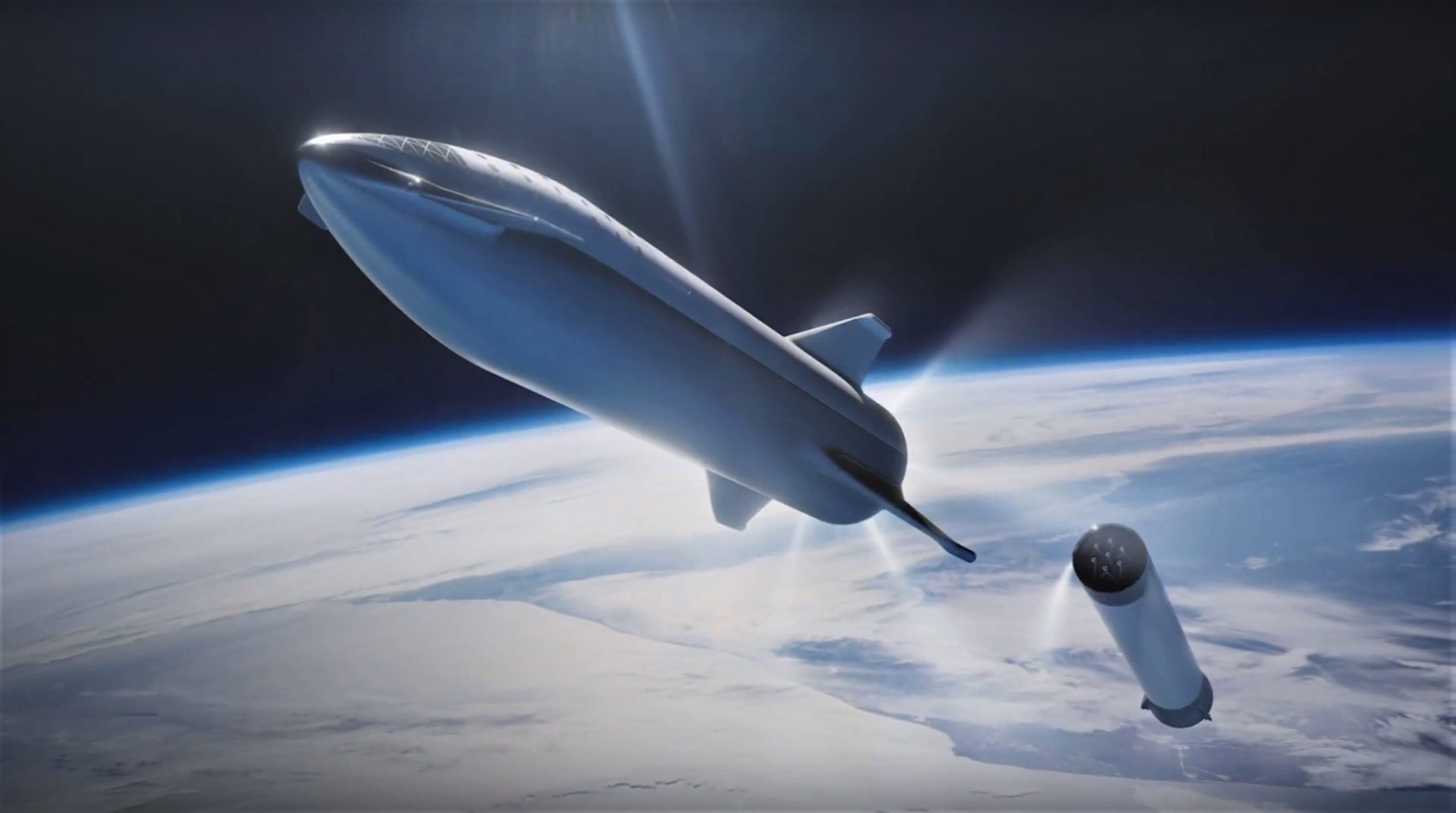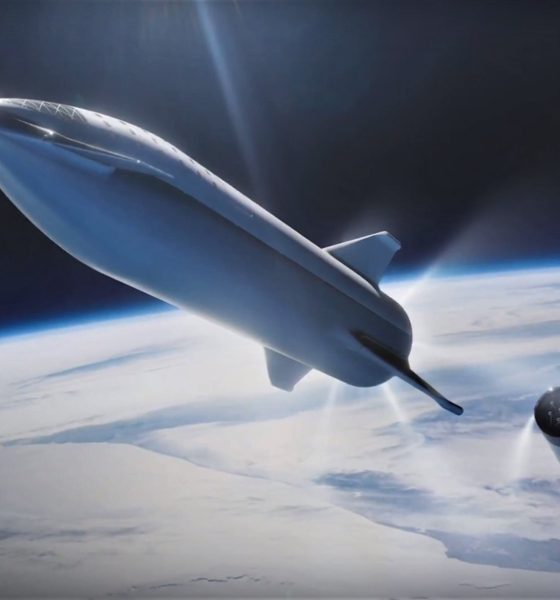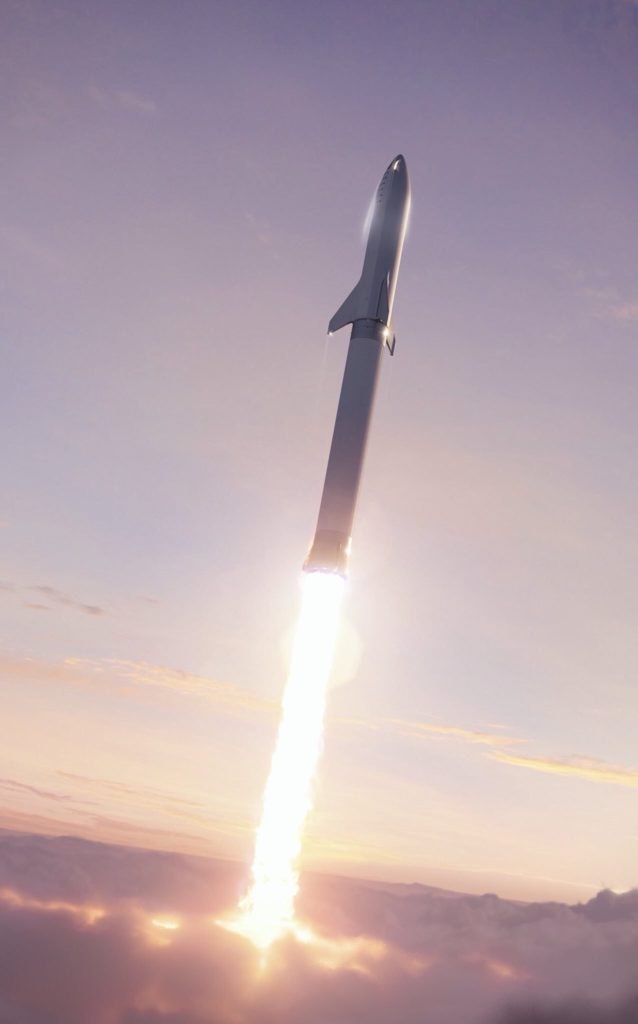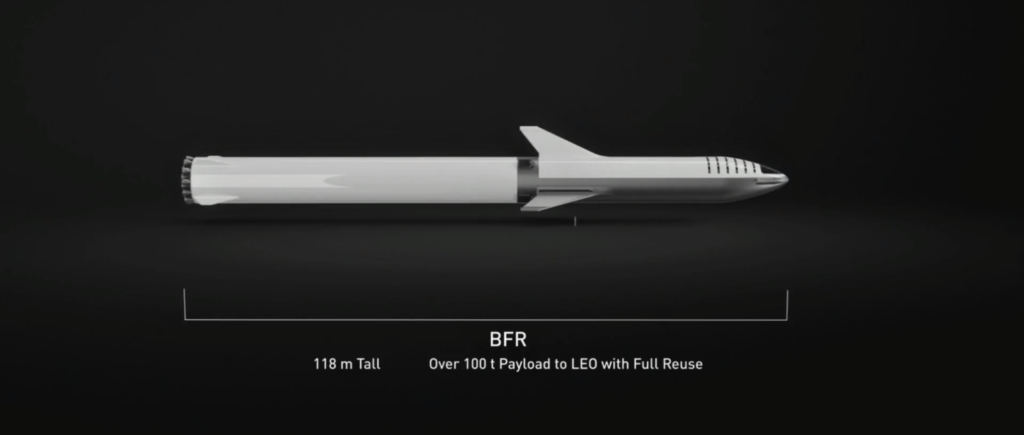

SpaceX
SpaceX’s BFR officially updated with new fins/legs, canard wings, and more
Speaking before a crowd of roughly 100 members of the press and even more SpaceX employees, CEO Elon Musk and lunar tourism customer Yusaku Maezawa presented and answered questions for more than an hour and a half, over the course of which Musk made public a number of updates to the company’s BFR booster and spaceship.
Maezawa, on the other hand, revealed a wholly unexpected plan for private lunar tourism deemed #dearMoon, built upon the goals of both (partially) funding development of BFR and placing a group of 6-8 international artists aboard a SpaceX spaceship for a journey around the Moon as early as 2023.
This is BFR from @spacex #dearMoon pic.twitter.com/jZiu1RHqUN
— 前澤友作 (@yousuck2020) September 18, 2018
Lacking no ambition, both BFR and #dearMoon have a vast amount of work to complete before their aspirations can be realized. Foundational to an unprecedented private voyage around the Moon, BFR is where this story begins, and SpaceX’s latest 2018 variation on the concept has departed from the 2017 vehicle’s design, with the majority of those changes centering around the upper-stage spaceship, known as BFS.
Those changes can generally be sorted into three main categories: new wings and fins, new operational strategies for spaceship landings, and new a Raptor engine layout.
- A full BFR booster and spaceship visualized during launch. (SpaceX)
- Rockets are perhaps even more capital intensive. (SpaceX)
- SpaceX’s 2018 BFR spaceship shows off new fins and forward canards, of which only the central tail fin is not an active control surface. (SpaceX)
Wings and fins
The most immediately visible difference between the spaceships of 2017 and 2018 can be found with both crafts’ aerodynamic surfaces and control implements. BFR (2018) now features three distinct fins in a tripod configuration, although Musk stated that the tail fin was scarcely a fin at all and essentially present for the sole purpose of being the third landing leg. Perhaps the most unusual feature of these new tripod fins is that the lower pair have been designed to be massive, agile control surfaces necessary for reentry and landing on planets or moons with significant atmospheres. Those three fins will simultaneously act as landing legs and critical control surfaces while operating in an atmosphere.
Additionally, BFR (2018) has been updated to include a pair of forward canards that will effectively act as a stand-in for grid fins on the spaceship, whereas the booster will simply have traditional titanium grid fins, judging from an official render of the full rocket. Compared with the delta wing or stubby winglets of 2016 and 2017 variants, BFR (2018) will have far more aerodynamic control authority, improving the versatility and stability of the vehicle during atmospheric reentry, flight, and landing on Mars, Saturnian moon Titan, and – most importantly – Earth.

Stay tuned for additional discussion of spaceship landings, changes to SpaceX’s Raptor engine strategy, and more later this week.
For prompt updates, on-the-ground perspectives, and unique glimpses of SpaceX’s rocket recovery fleet check out our brand new LaunchPad and LandingZone newsletters!

Elon Musk
Elon Musk’s Biggest Revelations on AI, Robots, and the Future of Work from the Moonshots Podcast

Elon Musk’s appearance on the Moonshots with Peter Diamandis podcast was packed with bold predictions, candid admissions, and surprising tech insights. The nearly three-hour conversation covered everything from artificial intelligence to humanoid robots, geopolitics, and the future of work. Here are the top 10 most intriguing takeaways:
-
Aggressive AGI Timeline Predictions
Musk offered a detailed view on when artificial general intelligence (AGI) could emerge, suggesting it may arrive sooner than many expect, emphasizing both transformative potential and risks.
-
U.S. vs. China in the AI Race
He discussed the strategic competition between the United States and China over AI development, noting that geopolitical dynamics will shape how and who leads in the next decades.
-
Future of Job Markets
Musk touched on how AI and automation could reshape employment, predicting massive boosts in productivity alongside potential disruptions in traditional work structures.
-
Clean Energy Transition
A recurring theme was the role of clean energy in future economies, with Musk reiterating the importance of scaling sustainable power generation and storage.
-
Humanoid Robots Are Coming
On the podcast, Musk elaborated on Tesla’s work on humanoid robots, hinting at timelines and applications that go beyond factories to general-purpose assistance.
-
Tesla Roadster “Last Human-Driven Car”
Outside the core discussion topics, Musk teased features of the upcoming Tesla Roadster — calling it “the best of the last of the human-driven cars” and suggesting safety won’t be its main selling point.
-
The Role of AI in Clean Energy and Robotics
Linking AI to both energy optimization and robotics, Musk explained how smarter systems could accelerate decarbonization and task automation across industries.
-
U.S. Innovation Leadership
Musk argued that maintaining American leadership in key tech sectors like AI, space, and robotics should be a national priority, with thoughtful policy and investment.
-
Job Creation vs. Job Elimination
While acknowledging automation’s disruptive effects, he also outlined scenarios where new industries and opportunities could emerge, particularly in AI, space, and advanced manufacturing.
-
Long-Term Vision for Humanity
Throughout the conversation, Musk revisited his long-term philosophical views — including a belief in humanity’s responsibility to become a multi-planetary and technologically empowered species.
Whether you agree with Musk’s optimism or not, the podcast offers a window into the thinking of one of the most influential figures in tech today, in and why his visions continue to spark debate and inspiration.
Elon Musk
Starlink achieves major milestones in 2025 progress report
Starlink wrapped up 2025 with impressive growth, adding more than 4.6 million new active customers and expanding service to 35 additional countries, territories, and markets.

Starlink wrapped up 2025 with impressive growth, adding more than 4.6 million new active customers and expanding service to 35 additional countries, territories, and markets. The company also completed deployment of its first-generation Direct to Cell constellation, launching over 650 satellites in just 18 months to enable cellular connectivity.
SpaceX highlighted Starlink’s impressive 2025 progress in an extensive report.
Key achievements from Starlink’s 2025 Progress
Starlink connected over 4.6 million new customers with high-speed internet while bringing service to 35 more regions worldwide in 2025. Starlink is now connecting 9.2 million people worldwide. The service achieved this just weeks after hitting its 8 million customer milestone.
Starlink is now available in 155 markets, including areas that are unreachable by traditional ISPs. As per SpaceX, Starlink has also provided over 21 million airline passengers and 20 million cruise passengers with reliable high-speed internet connectivity during their travels.
Starlink Direct to Cell
Starlink’s Direct to Cell constellation, more than 650 satellites strong, has already connected over 12 million people at least once, marking a breakthrough in global mobile coverage.
Starlink Direct to Cell is currently rolled out to 22 countries and 6 continents, with over 6 million monthly customers. Starlink Direct to Cell also has 27 MNO partners to date.
“This year, SpaceX completed deployment of the first generation of the Starlink Direct to Cell constellation, with more than 650 satellites launched to low-Earth orbit in just 18 months. Starlink Direct to Cell has connected more than 12 million people, and counting, at least once, providing life-saving connectivity when people need it most,” SpaceX wrote.
Elon Musk
Starlink passes 9 million active customers just weeks after hitting 8 million
The milestone highlights the accelerating growth of Starlink, which has now been adding over 20,000 new users per day.

SpaceX’s Starlink satellite internet service has continued its rapid global expansion, surpassing 9 million active customers just weeks after crossing the 8 million mark.
The milestone highlights the accelerating growth of Starlink, which has now been adding over 20,000 new users per day.
9 million customers
In a post on X, SpaceX stated that Starlink now serves over 9 million active users across 155 countries, territories, and markets. The company reached 8 million customers in early November, meaning it added roughly 1 million subscribers in under seven weeks, or about 21,275 new users on average per day.
“Starlink is connecting more than 9M active customers with high-speed internet across 155 countries, territories, and many other markets,” Starlink wrote in a post on its official X account. SpaceX President Gwynne Shotwell also celebrated the milestone on X. “A huge thank you to all of our customers and congrats to the Starlink team for such an incredible product,” she wrote.
That growth rate reflects both rising demand for broadband in underserved regions and Starlink’s expanding satellite constellation, which now includes more than 9,000 low-Earth-orbit satellites designed to deliver high-speed, low-latency internet worldwide.
Starlink’s momentum
Starlink’s momentum has been building up. SpaceX reported 4.6 million Starlink customers in December 2024, followed by 7 million by August 2025, and 8 million customers in November. Independent data also suggests Starlink usage is rising sharply, with Cloudflare reporting that global web traffic from Starlink users more than doubled in 2025, as noted in an Insider report.
Starlink’s momentum is increasingly tied to SpaceX’s broader financial outlook. Elon Musk has said the satellite network is “by far” the company’s largest revenue driver, and reports suggest SpaceX may be positioning itself for an initial public offering as soon as next year, with valuations estimated as high as $1.5 trillion. Musk has also suggested in the past that Starlink could have its own IPO in the future.











